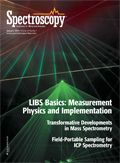LIBS Basics, Part I: Measurement Physics and Implementation
An overview for those considering implementation of LIBS to solve a particular analytical problem, and an introduction for those interested in learning more about LIBS. Part I concentrates on the basics of the measurement and typical implementation.

Laser-induced breakdown spectroscopy (LIBS) is an emerging analytical method that has been the focus of substantial research over the last 25 years. The recent emergence of commercially available LIBS systems from major manufacturers is a sign that the technology is maturing. This column is the first of a three-part series focusing on major aspects of LIBS. This installment concentrates on the basics of the measurement and typical implementations. Part II will discuss the choices for LIBS hardware in detail, in particular lasers and spectrometers, and illustrate the trade-offs between cost, size, and performance. Part III will discuss LIBS analysis in some depth, exploring the various ways to go from a LIBS spectrum to a solution. Overall, this column series is intended to provide an overview for those considering implementation of LIBS to solve a particular analytical problem, and an introduction for those interested in learning more about LIBS.
Laser-induced breakdown spectroscopy (LIBS) has been the subject of a number of recent books (1,2) and numerous review papers (3–5). Widely referenced charts in the introduction of the Cremers and Radziemski book (1) and the first chapter of Noll's book (2) illustrate the dramatic increase in the annual number of LIBS papers from near zero through the 1970s to an annual rate of approximately 300–400 today. As an example, Figure 1 shows the annual rate of papers and patents containing "LIBS" or "laser-induced breakdown" in their titles from Google Scholar (6). Interestingly, the past few years may indicate a leveling in the publication rate, and the data can be closely modeled by the following logistic function:

Although it is too early to determine whether the leveling in the rate will be continued, if this trend holds the annual publication rate would peak around 500 per year, which is the equivalent of about three full monthly journals on an annual basis.
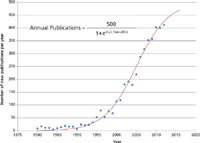
Figure 1: Annual rate of publications and patents containing "LIBS" or "laser-induced breakdown," from Google Scholar. Accessed August 29, 2013.
Clearly, there has been much progress in the science and application of LIBS. Today we increasingly see LIBS units in corporate laboratories and even controlling industrial processes. LIBS is deployed to take advantage of a number of positive attributes, which include minimal sample preparation, particularly compared with methods requiring digestion; speed of analysis; sensitivity to light elements, particularly compared with X-ray fluorescence (XRF); and "stand-off" ability in which the LIBS system is removed by distances of anywhere from millimeters to meters from the sample being measured. Because of these advantages there has been an explosion of interest in LIBS (see Figure 1) over a wide range of applications. However, LIBS is a complicated measurement, with special considerations related to the sample matrix and working hardware folded into the ablation process and the analytical laser plasma. Understanding the trade-offs between various component choices in a LIBS system, as well as the basic hardware arrangements, is key for a successful implementation of LIBS.
Physics of LIBS
Ablation
One of the benefits and drawbacks of LIBS with a single laser pulse is that the same laser pulse is used for sample preparation (ablation) and analysis (laser plasma). A high-energy pulsed laser is focused into a small spot on a sample. For a typical nanosecond-class laser, the initial portion of the laser pulse penetrates into the sample and causes ablation of the solid sample. The duration of such a laser pulse is several orders of magnitude more than the characteristic lattice vibration time in a solid, meaning that local heat transfer is relatively fast compared with the characteristic time of the laser pulse. Hence, particularly for more conductive materials, nanosecond-class laser ablation results in a substantial amount of heating and melting of the sample. The rapid heating because of the high fluence of a nanosecond-class LIBS pulse typically leads to an explosive boiling process that can eject liquid and even solid-phase particles from the ablation target. The resulting crater, viewed under high magnification, often closely resembles a crater on the moon, with high walls created during "impact" and surrounded by ejected material.
As the laser pulse progresses in time, the high electric field in the focal region of the laser begins to accelerate naturally present ions, plus ions formed via multiphoton interactions in the atmosphere above the sample, and from the sample itself. These free electrons increase the absorption of the laser in the atmosphere above the sample, leading to greater multiphoton ionization and further absorption of the laser pulse. Electron impact ionization and dissociation can also become important. Longer wavelengths are more readily absorbed in the forming plasma, with the implication that infrared (IR) laser wavelengths form a more robust plasma than do ultraviolet (UV) laser wavelengths in general. Simultaneously, the relatively dense cloud of ejected and vaporized material in the ablation plume above the sample may also be absorbing laser photons in the region tens of micrometers above the surface. In time, depending on the wavelength of the laser, much of the trailing part of a 4–8 ns laser pulse may be absorbed in the atmosphere above the sample. This forms the analytical plasma.
Lasers with picosecond pulse durations follow generally the same process as described above for nanosecond-class lasers because the laser pulse is still long with respect to solid lattice vibrations, and hence heat transfer in the sample is still important in the ablation mechanics. However, LIBS with femtosecond lasers is quite different. Femtosecond lasers have pulse durations short enough that heat transfer in the sample is not important and sample melting is minimized; thus, ablation is much more of a mechanical process, with direct photochemical bond-breaking and Coulomb explosion among the primary ablation mechanisms. Femtosecond ablation craters are much more precise than craters from thermally dominated ablation of nanosecond-class lasers, with a minimal residual heat affected zone. Because of the nonthermal nature of the ablation, with femtosecond lasers there is much less of a problem of preferential desorption and nonstochiometric ablation than with nanosecond lasers. However, given the substantial cost and complexity increase of femtosecond lasers over nanosecond lasers, they remain a research tool. In large part, this is because of the fact that there is little or no evidence that overall detection limits are improved with femtosecond lasers over nanosecond lasers in LIBS.
Plasma
The resulting laser plasma forms the analytical engine for LIBS. Interestingly, LIBS plasmas formed over a wide range of total energies follow a roughly self-similar time-temperature history as they cool, parameterized by the energy deposited in the plasma. Initially in a severe state of disequilibrium, with "temperatures" in excess of 50,000 K, analyte particles are vaporized and the analyte is dissociated, with resulting atoms and ions electronically excited. "Temperature" is in quotation marks as temperature is ill-defined when the plasma is in a high degree of disequilibrium. In this condition, electron temperatures, ionization temperatures, and electronic, vibrational, or rotational excitation temperatures may be significantly different as energy cascades through the plasma. The plasma cools rapidly after the laser energy source is removed. The highly-excited free electrons in the plasma slow, and due to conservation of energy emit a broadband continuum of light referred to as Bremsstrahlung emission. During this phase, "temperature" is high enough that only very high electronic states of atoms relax in sufficient numbers to emit, but this emission is typically overpowered by the continuum.
LIBS emission is typically collected after the plasma approaches local thermodynamic equilibrium (LTE), which may be 0.5–1 µs after formation of a 100–400 mJ plasma, but may be much less time if lower laser energies are used. When the plasma approximates LTE, temperature can be clearly defined, as there is a match between molecular temperatures and electron temperatures. For this reason, higher-energy (>5–10 mJ) LIBS plasmas typically use detectors that can be triggered "on" at a point in time after the continuum emission has reduced and the plasma is in LTE. Plasmas with smaller deposited energy may be able to use detectors that are not triggerable because the continuum emission is much less intense. In addition, some detectors such as intensified charge-coupled devices (CCDs) and electron-multiplying CCDs can gate both "on" and "off," allowing a precise window of emission to be collected. Photomultiplier tubes with integrating electronics can also time-gate in this manner. The optimum emission window for each element is a function of the upper and lower energy levels of the emission line being monitored (7). Typically the average plasma temperature during the time of the emission measurement is in the range of 7500–10,000 K. Figure 2 is a conceptual illustration of the plasma emission and collection time line.

Figure 2: Conceptual illustration of plasma emission and collection time line for various moieties in the plasma.
An example of the resulting LIBS spectrum is shown in Figure 3. Much like in inductively coupled plasma–optical emission spectrometry (ICP-OES) or other emission methods, multiple emission lines are shown from most of the elements present in the sample. Individual emission lines can be used for quantification over fixed ranges of concentration, or individual lines can be combined either in a piecewise fashion or in a multivariate calibration to yield a potentially more robust calibration over a wider range of concentrations. As indicated above, because of the coupling of the laser pulse in the ablation and the plasma formation, the resulting emission (and calibration) is dependent on both the experimental parameters (laser wavelength, energy, and spot size, to start) and the material. A deeper dive into analysis of LIBS spectra will be covered in part III of this series.
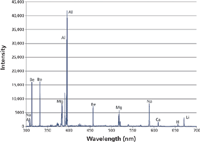
Figure 3: LIBS spectrum of a gemstone, showing multiple elements and multiple lines in a typical spectrum. This spectrum was recorded using a single 10-mJ, 266-nm laser pulse and an echelle spectrometer with an intensified camera, using a gate delay of 1 µs.
Methods of separating the laser ablation process and the LIBS diagnostic plasma have proven to be profitable both in improving detection limits (double-pulse LIBS) (8), and in moving toward matrix- or sample-independence (laser ablation-LIBS) (9). A review of these additions to the method is beyond the scope of the article, and insofar as commercial systems are presently based on "single-pulse" LIBS, can be left as the subject of continued research.
Typical Hardware and Configurations
The basic LIBS setup is shown in Figure 4. It consists of a pulsed laser, possibly a video camera or other range-finder, beam-shaping and steering optics, collection optics, and a wavelength-sensitive detector (most commonly the combination of a dispersive element and a detector).
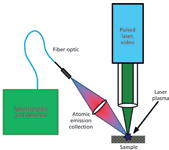
Figure 4: "Basic" LIBS setup including major hardware components.
Laser
The choice of laser becomes one of the first decisions when considering a LIBS system. Typically, but not always, the choice is an Nd:YAG laser operating at the fundamental wavelength of 1064 nm or one of the harmonics (532, 355, or 266 nm being the most common). More than anything, this choice is driven by cost, as the Nd:YAG is able to deliver the lowest cost per joule of laser energy. Flashlamp-pumped Nd:YAG lasers are available in a range of energies in the fundamental from 10–500+ mJ, and for between $10,000 and approximately $35,000+ USD. Nd:YAG is also available with lower pulse energies, but not typically in commercial quantities. In commercial systems, flashlamps typically last between 20 million and 50 million shots, the latter being "only" about 2 months if the laser is run at 10 Hz, 24/7, but several years under common laboratory conditions. Diode-pumped Nd:YAG lasers have lifetimes that are easily 50–100 times longer than their typical flashlamp-pumped counterparts. Several older studies have used excimer (typically ArF 193 nm) or pulsed CO2 lasers, among a variety of pulsed lasers.
Beyond laser pulse energy, the wavelength of the laser is important in determining the efficiency of the ablation and the ratio of laser energy absorbed in the material to that absorbed in the plasma, which for a solid material sits above the sample surface. In brief, shorter wavelengths are more effective at ablation, because the more energetic photons more likely exceed the bandgap of the material and can cause molecular bond-breaking. Shorter wavelengths can also make smaller spots on the material, resulting in a higher fluence than an equivalent-energy pulse from a longer-wavelength laser. However, the trade-off comes from the fact that longer-wavelength photons are better absorbed in the evolving plasma, so a more robust plasma is created with longer-wavelength lasers. In fact, this increased absorption in the plasma also shields the sample from a portion of the laser beam, which is referred to as "plasma shielding." A detailed discussion of this trade-off between ablation efficiency and plasma formation will be covered in part II of this column series, which covers hardware choices in more detail.
Emission Detection
At the most basic, detection of a LIBS single emission line can be accomplished with a bandpass filter and a single-point optical detector such as a photodiode or a photomultiplier tube (PMT). In fact, such an arrangement, with the addition of a second detector for a background or a baseline, can work well for simple systems in which one or only a few known elements are being measured. Otherwise, a variety of combinations of spectrometers (Czerny-Turner, echelle, or Paschen-Runge) and detectors (PMT, CCD, intensified CCD, or electron-multiplying CCD) are used for detection. Key variables in the selection of the dispersion or detection pair include required wavelength resolution, sensitivity, and detector gating and time resolution, as well as a match between the spectral range of the detector and the emission lines of the elements to be measured. Most LIBS emission lines are in the 180–500 nm range, with a few key elements having lines in the 500–850 nm range.
Common Hardware Configurations
The basic LIBS setup was shown in Figure 4. There are several offerings in the marketplace that are essentially desktop devices designed as a tool for laboratory analysts to make routine and exploratory measurements, potentially in conjunction with other instruments. Typically, these instruments have movable sample stages monitored by video, Class 1 sample chambers, and analytical software that allows familiar functions for analysts such as library building, calibration curves, elemental ID, and spectral analysis. Such laboratory systems are used for a variety of functions in material identification, qualitative analysis, and quantitative analysis. Surface mapping and depth profiling are also possible. These laboratory systems excel at analysis of solid materials.
The analysis of liquid phases is somewhat more complicated than solids. There is clearly the propensity of liquid samples to splash when interacting with the laser plasma. As with solid samples, it is key to maintain a consistent lens-to-sample distance to achieve a constant fluence on the sample. These two facts are at odds with each other if a high-repetition rate laser is used. Approaches to measuring liquids on a free surface interface include measurements over a weir or measurements in a laminar jet (10). In both cases, the laminar nature of the flow results in a very predictable location for the free surface of the fluid. LIBS combined with laser-induced fluorescence (LIF) on a free surface has been shown to improve detection limits (11). Other approaches include single- or double-pulse LIBS within the liquid volume, with the latter case forming a second plasma inside the cavity formed by the first. Based on work by Professor Mike Angel of the University of South Carolina and others, double-pulse LIBS has been shown to have an advantage at typical pressures, but at the substantially elevated pressures typical of the sea floor, single-pulse LIBS has an advantage (12). Overall, detection limits for particular elements in liquids compared with solid materials are not as good, typically by an order of magnitude or more, because of the interaction with the liquid. Commercial adaptations of methods for LIBS measurement of liquids are available on the market.
Gas composition is similarly easy to measure, and is much less sensitive to matrix effects because of the fact that there is no ablation event. Our group and others have applied this to measurement of mixing ratio between gases in turbulent fluid flows, and to air and fuel ratio measurements in combustion systems. In conjunction with Professor Paul Puzinauskas' group at the University of Alabama, this was even achieved through a fiber optic in a working engine (13). From the measurement of gases, it is also a small step to measure bulk aerosol suspended in the gas. Substantial work on measurement of individual aerosols has been accomplished by Professor David Hahn's group at the University of Florida (14), as well as work by our own group and several others. Bulk aerosol suspended in air or another carrier gas tends to yield repeatable and relatively simple calibration curves, while individual aerosol quantification remains a challenge.
Finally, LIBS configurations that employ the standoff detection of LIBS have been used, particularly on solid samples. Examples of this can be found in industrial scenarios, in which LIBS has been used for measurement of coal, phosphate ore, and the composition of scrap metal. Truly "extreme" standoff LIBS measurements have been accomplished by the Laserna group at the University of Málaga, who have recently surveyed major and trace elements in the materials on the Cathedral of Málaga, Spain, from an average distance of 35 m (15). Previous research by that group has included work at even greater distances to identify traces of explosives. The LIBS work at extreme standoff distances remains experimental or prototype in nature, but the industrial applications mentioned above all have had commercial prototypes and (in a few cases) commercial sales.
Summary
This column, part I in a three-part series, was written with the aim of explaining the basic considerations surrounding the physics and hardware choices that are important for making successful LIBS measurements. We've covered these topics, as well as the main modes in which LIBS is deployed for measurements on solids, liquids, and gases. As we've seen, the ablation event and the plasma are strongly dependent on both the sample matrix and the choice of LIBS hardware. For this reason, it is difficult to imagine a "universal" LIBS system or calibration; rather, the systems and calibrations are tailored for particular applications. In parts II and III of this series, we will focus in more depth on specific hardware components that might be considered for particular applications and on analysis methods that are required to translate a LIBS spectrum into an actionable answer — either qualitative or quantitative.
References
(1) D.A. Cremers and L.J. Radziemski, Handbook of Laser-Induced Breakdown Spectroscopy (Wiley, Hoboken, New Jersey, 2013).
(2) R. Noll, Laser-Induced Breakdown Spectroscopy: Fundamentals and Applications (Springer, Heidelberg, Germany 2012).
(3) F.J. Fortes, J. Moros, P. Lucena, L.M. Cabalin, and J.J. Laserna, Anal. Chem. 85, 640–669 (2013).
(4) D.W. Hahn and N. Omenetto, Appl. Spectrosc. 64(12), 335–366 (2010).
(5) D.W. Hahn and N Omenetto, Appl. Spectrosc. 66(4), 347–419 (2012).
(6) Google Scholar (n.d.). Retrieved August 29, 2013, from http://scholar.google.com/.
(7) B.T. Fisher, H.A. Johnsen, S.G. Buckley, and D.W. Hahn, Appl. Spectrosc. 55(10), 1312–1319 (2001).
(8) J. Scaffidi, S. Angel, and D.A. Cremers, Anal. Chem. 78(1), 24–32 (2006).
(9) B.C. Windom and D.W. Hahn, J. Anal. At. Spectrom. 24(12), 1665–1675 (2009).
(10) M. Taschuck et al., "Laser-Induced Breakdown Spectroscopy of Water Samples with Millijoule Pulse Energies," Plasma Science /ICOPS, The 29th IEEE International Conference on IEEE, 2002, p. 140.
(11) H. Loudyi, R. Kheireddine, S. Laville, F., Vidal, M. Chaker, and M. Sabsabi, J. Anal. At. Spectrom. 24(10), 1421–1428 (2009).
(12) J. Bonvallet and S. Angel, "Deep Ocean LIBS: Calibration Issues," presented at The Great Scientific Exchange (SciX 2013), Milwaukee, Wisconsin, 2013.
(13) F. Ferioli, P.V. Puzinauskas, and S.G. Buckley, Appl. Spectrosc. 57(9), 1183–1189 (2003).
(14) P.K. Diwakar, K.H. Loper, A.-M. Matiaske, and D.W. Hahn, J. Anal. At. Spectrom. 27(7), 1110–1119 (2012).
(15) I. Gaona, P. Lucena, J. Moros, F. Fortes, J.S. Guirado, and J. Laserna, J. Anal. At. Spectrom. 28(6), 810–820 (2013).
Steve Buckley is a Director of Market Development at TSI Incorporated, which acquired the LIBS business of Photon Machines, Inc., in 2012. Prior to cofounding Photon Machines, Steve was a tenured professor of engineering at the University of California at San Diego. He has been working on research and practical issues surrounding the implementation of LIBS since 1998.
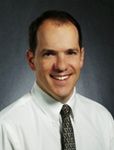
Steve Buckley
Newsletter
Get essential updates on the latest spectroscopy technologies, regulatory standards, and best practices—subscribe today to Spectroscopy.
New Study Expands Nickel Autoionization Spectra to Advance Laser Isotope Separation Technologies
July 17th 2025Researchers at China’s National Key Laboratory have identified 170 nickel autoionization states using resonance ionization mass spectrometry, significantly advancing the spectral database critical for laser isotope separation and atomic spectroscopy.
Laser Ablation Molecular Isotopic Spectrometry: A New Dimension of LIBS
July 5th 2012Part of a new podcast series presented in collaboration with the Federation of Analytical Chemistry and Spectroscopy Societies (FACSS), in connection with SciX 2012 — the Great Scientific Exchange, the North American conference (39th Annual) of FACSS.
Developing Sensitive Optical Methods for Early Disease Detection
May 5th 2025Noureddine Melikechi, dean of the Kennedy College of Sciences and professor at the University of Massachusetts Lowell, shares his work on the early detection of diseases like epithelial ovarian cancer and Alzheimer’s.
